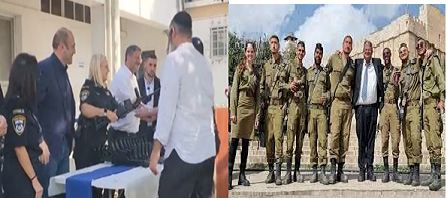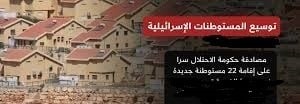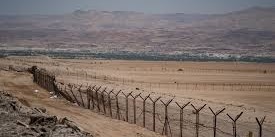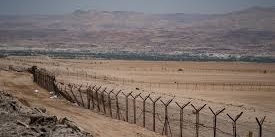By: Madeeha Al-A’raj
The national Bureau for Defending the Land and Resisting Settlements stated in its latest weekly report , that Israeli occupation brutal attacksagainst Gaza Strip cast shadow on the West Bank in numerous ways, as it has imposed martial law,and unleashed settlers hand to escalate their attacks on Palestinian citizens, especially during the olive harvest season, as well as imposing a tight military security cordon on the West Bank, dismantling it into ghettos due to the security system that imposed similarly on Palestine in the 1948 territories for 20 years after the Palestinian ‘Nakba’, and the measures that accompanied what was called ‘Operation Defensive Shield’in the West Bank after 2002.
Moreover, military checkpoints, andSmotrich and Ben Gvir terrorist militias, including the ‘Hill Top Youth’ “Pay Price’ ‘Rebellion’ and other Jewish terrorist organizations, which take the settlements, outposts, and so-called “pastoral farms” as safe havens and launching stations for attacks on Citizens in the Palestinian countryside. More than 500 military checkpoints were deployed by the occupation forces on the streets, crossroads, and entrances to Palestinian towns and villages, and severe restrictions were placed on the movement and mobility of Palestinian citizens through field measures that began by closing hundreds of areas between Palestinian cities and villages, redeploying iron gates in many areas, and completely closing areas and roads, especially those shared by settlers, and Palestinians.
Furthermore, the occupation army unleashed herds of settlers to escalate their attacks and do everything they to terrorize citizens and damage their property, especially in towns and villages adjacent to settlements throughout the West Bank, where the herds of settlers assume the role of the occupation army in imposing military orders and a comprehensive closure on citizens and preventing them from moving and leaving their towns or reaching their farms and lands during the olive harvest season.
The fascist and neo-Nazi government in Israel drew a major lesson from Oct. 7th, under the pressure of accusations of negligence. The army has deployed 24 brigades throughout the West Bank, turned them into a guard for the settlements and settlers in their outposts, terrorist pastoral farms and for the convoys practicing Talmudic rituals at the tomb of the Prophet Joseph, and the altar of Joshua Yin Nun and other sites that are evoked from legends to build an imaginary history in this country.
In addition the army moved to the fighting fronts in the south on the Gaza Strip border and in the north on the southern Lebanon border and handed over the mission to the so-called Border Police, the National Guard, and the Smotrich and Ben Gvir militias in army uniform, after distributing hundreds of rifles to them under the direct supervision of Ben Gvir.
Not only Ben Gvir, as Minister of National Security of the occupying state promised 20.000 weapons to the settlers from his website on the ‘X’ platform ‘Twitter’, but he also went beyond self-initiatives from the leaders of the settlement councils. The beginning was with the Northern West Bank Settlements Council, which distributed hundreds of rifles to the settlers, as a precautionary measure, as stated on the Hebrew website ‘0404’, after the head of this council, Yossi Dagan, was able to purchase 300 automatic rifles from donations from American Jews for the benefit of the settlers in a deal worth millions of shekels. The first batch was the distribution of 200 to be followed by distributing another 100 in the coming days.
In light of that, effects of the Israeli aggression and war on the Gaza Strip extended to include all aspects of life in the occupied West Bank, including Jerusalem. Hardly any sector of the Palestinian economy escapes the effects of those harsh military security arrangements. Within this context, the continuation of the aggression on the Gaza Strip, many industrial, agricultural and commercial production projects were disrupted, and the suffering of Palestinian farmers was greatly exacerbated, including those whose lands and farms are located behind the apartheid wall in many Palestinian areas in the Governorates of Jenin, Tulkarm, Qalqilia, Salfeet and others simultaneously with the harvest season in the fields of guava, citrus, avocado and olives.
In this report, we present facts, but not limited to the suffering of Palestinian farmers as a result of the policy pursued by the occupation government and its effects on the Palestinian national economy and on the lives of these farmers. In SalfeetGovernorate, which is considered one of the largest olive oil-producing in Palestine, the area of its land planted with olive trees is estimated at about 43,000 dunams, most of which are located in areas C and close to settlements and bypass roads. Farmers in the villages of Yasuf, Iskaka, Kafr-Dik, Kifl Hares, Marada, Burqin, Farkha, QarawatBani Hassan, Bidya, and the city of Salfit itself are subjected to a series of attacks, beating and shooting farmers, stealing crops, and cutting down trees with the aim of terrorizing citizens, expelling them, and preventing them from practicing their work of picking olives under the protection of the occupation army.
In Nablus, things seem more complicated as terrorist settlement outposts and pastoral farms are scattered here and there, starting with the villages of Hawara, Burin, Madama, and Asira al-Qibliya, passing through the towns of Beita and Yatma, and ending with the villages of Qasra, Juresh, Talfit, Qaryut, and Jalud. The crimes of Jewish terrorist organizations are difficult to quantify and have worsened in light of the barbaric aggression against the Gaza Strip.
Crimes has begun with leveling and stealing land on the road between the villages of Qasra and Jalud in the area where the “Shilo” and “Eli” settlements and terrorist outposts such as “EshKodesh” and “Eli Ad” are located, they continue in the dawn hours with raids on the villages of Qaryut, Jalud, and Talfit, amidst gunfire and burning of homes, and in broad daylight martyrs fall, as is the case in his palace, which recently lost 6 of its peopleby settler fire, ending up preventing farmers from harvesting their olives in fields far away200 mfrom their homes.
The Palestinian pastoral communities also subjected to the violence and terrorism of settlers these days, taking advantage of the circumstances of the aggression against the Gaza Strip and the closure of the West Bank. Since the outbreak of the war, a wave of Palestinians has begun to flee, leaving the herding communities in the West Bank. Here we are talking about communities that have been emptied of residents, and in other cases about the departure of several families or the evacuation of women and children.
Some residents reported that they have been threatened by armed settlers telling them to leave and receive threatening calls from settlers impersonating a Shin Bet official. Most of the residents of AinShibli, east of the city of Nablus on the Jordan Valley road, fled, according to accounts reported by Israeli media such as Haaretz Newspaper in recent days. Others gathered their belongings because a settler named Moshe Sharbit, who lives in the nearby settlement outpost ‘EmekTirza’, also called Moshe’s Farm, gave them only 5 hours to leave.
Allresidents of the village of Wadi al-Siq were also evacuated; about 20 families escaped with their lives and fled the place due to the ongoing acts of abuse by the settlers. This Wadi Al-Siq is located in the middle of the West Bank in the area of the MaaleMikhmas settlements, near the farm of a settler named Neria Ben Bazi.
On the other hand, Minister of Finance and the Minister of Settlements in the Ministry of the Army, BezalelSmotrich, is pushing to allocate about NIS 7 billion to strengthen his base and allies in the settlements in the West Bank, in coordination, cooperation and partnership with Itamar Ben Gvir, head of the “Jewish Power” party and head of the Council of Settlement Communities in the West Bank, Shlomo Neman, as well as his typical fascist colleague, who last March called for the annihilation of the town of Hawara, Yossi Dagan, head of the so-called settlement council in the northern West Bank.
Israeli media revealed that during his meeting with his allies in the middle of last week, he was taking advantage of the war conditions to advance his program, as he confirmed that the current Israeli government is preparing for a leap in its project to regain what it called control over the lands of “Judea and Samaria” and support settlement in all its forms. In his meeting with the residents of the Gaza Strip border, who were displaced from the border settlements due to the war, Smotrich proposed to the Council of Settlement Communities to host the settlers who were transferred from the settlements on the Gaza Strip and the Lebanese borders to reside in settlements in the vicinity of Nablus, Ramallah, and Hebron, a step towards increasing the number of settlers in the area.
The West Bank has one million settlers, and the number of those Smotrich intends to “host” and absorb in West Bank settlements is estimated at approximately 130,000 displaced one. In any case, this plan, which he presented to senior settlers before presenting it to the government, falls within the extension of the same plan, which he presented last August for which $180 million was allocated at the time to the settlements, including the settlement outposts.
In Jerusalem, the occupation municipality urgently approved the construction of a rehabilitation center on the lands of the village of Al-Issawiya, while Israeli Minister of Health, Museh Erbil visited Hadassah Hospital on Mount Scopus as part of preparations for the possibility of expanding the war on the Gaza Strip and the possibility of Hezbollah and Palestinian factions from southern Lebanon joining this war, among the sensitive issues that the security and health authorities discussed with the occupation municipality in Jerusalem was the completion of the construction of this rehabilitation center.
At the end of his visit, Erbil expressed his admiration for what had been accomplished in record time, explaining that he had met dedicated and professional people, which is impressive to see how 2 main underground complexes were built in Hadassah Hospitals in one week through hard teamwork in order to house more than 100 patients, according to his description, indicating that Israel is accelerating the completion of the construction of the largest rehabilitation center in East Jerusalem in preparation for the possibility of escalation in the war on the southern and northern fronts in cooperation between the Ministries of Health and Security and the municipality of Moshe Lion.
The occupation municipality revealed that the cost of the rehabilitation center is estimated at NIS 250 million. Most of it comes from donations and the government. This center for which the foundation stone laying ceremony took place at the beginning of 2019 is located on a large area of land in the village of Al-Issawiya from the eastern side overlooking the desert of Jerusalem and the Dead Sea.
In Salfeet, settlement continues to creep into the remaining lands of this governorate to which settlement and settlers have not extended their hand yet. Though the occupation bulldozers continued to bulldoze areas of the land of the Derastiatown in favor of constructing a settlement road in the ‘Al-Masahil’ area north of the town linking the ‘Emmanuel’ settlement to other settlements in the area after they had seized 900 dunams of the town’s land. Bulldozing work also continued to build a settlement road in the northwestern area of the lands of the town of Kafr-Dik after it seized dozens of dunums in the “Safat al-Masry” area to build a road to encircle the Beduel settlement through which the northern and western areas of the town, which is known as the “Banat Bir”.
List of Israeli Assaults over the Last Week Documented by the National Bureau:
Jerusalem:
- Demolishing a commercial store belonging to the citizen MajedAttoun, under the pretext of not having a license, in the Sur Bahertown, south of Jerusalem, and a house belonging to the family of FadiJa’far in the town of Jabal al-Mukabber, in the south, and they imposed a heavy fine on him of about NIS 35,000 on the pretext of building without a license, and a third house in Sheikh Jarrah Neighborhood for the Jerusalemite citizen Ishaq Abu Jibna.
- Forcing the citizen, Ibrahim Al-Malhi, to demolish his house in the BeitHaninatown under the pretext of not having a license.
- Attacking the people of the Al-Sawana Neighborhood then started throwing stones at them, wounding 3 people, 2 with rubber bullets.
- Damaging tires of 10 vehicles in the BeitIksa village.
Hebron:
- Notifying to seize more than 2 dunums of land from the town of Surif in the “KhalletSalama” area near the Al-Jabaa military checkpoint, for military purposes.
- Raiding the Al-Khalaarea adjacent to the “KermeiTzur” settlement, south of Beit Umar, and bulldozed lands and uprooted 25 forest trees.
- Firing live bullets at citizens, bulldozing land with an area of about 6,000m2, and uprooting 55 forest and almond trees in the village of Al-Tuwanah.
- Attacking the MasaferYatta, anumber of citizens were injured,others sustained bruises as a result of being subjected to severe beatings and electric shocks by settlers in the Fateh Sidra area.
- attacked the home of citizen Samir Al-Hamamdehin the village of Al-Fakhit, assaulted and beat him, tookhis tablets and flashlights, and destroying the contents of his house.
- Wounding 2 young men by live bullets after the occupation forces fired bullets at farmers while picking olives in the “Towal Musa” area surrounded by the Apartheid Wall.
- Uprooting 30 olive and grape trees, destroyed water tanks, cut off solar energy extensions, and stole other equipment near the Sha’b al-Butm area in MasaferYatta after storming the “Um Tarit” Bedouin community near Sha’b al-Butm. They also contaminated water wells and threatened citizens of Khirbet Maghayir al-Ubaid with deportation and death after searching caves and homes and terrorizing children.
Bethlehem:
- Attacking farmers in the Al-Khadertown and forcibly prevented them from reaching their lands to pick grapes, in the areas of “Wadi Al-Abyar,” “Wadi Al-Ghuwait,” “Khallet Al-Fahm,” “Al-Sha’afWadi Al-Shami,” and “Sahl Al-Rajm.”
- Stealing olive fruits from lands in the Al-Makhrour area west of theBeitJala city and prevented the land owners from reaching them in light of the tight siege on the Bethlehem Governorate, which the settlers exploited to seize Spaces to expand the settlement outpost.
- Assaulting citizens in the village of Kisan while they were in the Abayat wilderness, some of them sustained bruises.
Nablus:
- Attacking farmers in the Qabalantown, south of Nablus, vandalized agricultural rooms, and stole olive harvesting equipment.
- Forcing olive pickers in the lands adjacent to the bypass road near Burin and Duma village to leave their lands and deprived them of harvesting the fruits. Preventing farmers from the town of Sebastia from picking olives and forced them to leave their lands located outside the fence of the “ShafiShomron” settlement, which prevented them from being able to pick olives. Burning scores of vehicles in Hawara during settlers attack on the town after they carried out acts of orgy and provocation. They attacked homes with stones and bullets and set fire to a used vehicle shed belonging to the citizen Muhammad Odeh. The fire destroyed dozens of vehicles inside it before civil defense crews were able to control them.
- Beating a citizen while picking olives in the Al-Mantara area in the village of KafrQalil, detained 5 others while in the Qablan town.
- Torching a house on the outskirts of the village of Talfit, about two hundred kilometers away from the settlement fence, forced farmers to leave their lands in Khirbet Yanun, which is part of the lands of Aqraba, and prevented them from continuing to work there, especially in the northern and eastern area.
- Escaping death following an attack by settlers on the family of citizens Morsi and ObaidaEid in the Burin town while they were picking olives, they were able to escape after they were burned.
- Smashing a vehicle and an agricultural tractor and destroyed all the tools that the farmers were using to pick olives in the Qusratown.
Jenin:
- Attacking farmers in the village of Zabuba and opened fire on them, preventing them from reaching their agricultural lands adjacent to the apartheid wall. They also warned them not to approach the wall.
- Citizens’ homes in the Jalbounvillage are also constantly subjected to heavy gunfire from inside the nearby “Merav” settlement, prevented them from picking olives at gunpoint.
- Seizing a house belonging to the citizen Loai Ali Mahmoud Abu Eid in the Faqoua village, housing 8 individuals, expelled them from it, as the forces informed them that the house became a military monitoting point.
Jordan Valley:
- Attacking citizens’ homes in the Arab Al-Malihat community on Al-Ma’rajat Road, west of Jericho, and threw stones at them before forcing them to flee, while others threw blood-stained dolls in front of the Arab Al-Kaabna Basic School in Al-Ma’rajat, west of Jericho to create an atmosphere of terror and intimidate the school’s students.
- Running over sheeps belonged to Hassan Kabnah in the Tal Al-Samadi area in Al-Jiftlik, leading to the death of a number of them.
 المكتب الوطني للدفاع عن الارض ومقاومة الاستيطان منظمة التحرير الفلسطينية
المكتب الوطني للدفاع عن الارض ومقاومة الاستيطان منظمة التحرير الفلسطينية




